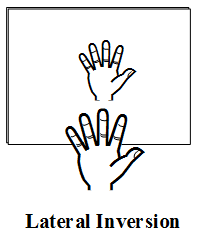How would you Describe the Image Formed by a Plane Mirror
Reflection from the Plane Mirror
Relation between the distances of the object and the image from the plane mirror is that they are equal.
To verify this, consider the geometrical construction shown in figure. Rays OP and OD, starting from the object O, fall on the mirror. The ray OP is perpendicular to the mirror and hence, reflects back along PO. The incident ray OD and the reflected ray DE make equal angles with the normal DG. The two reflected rays when produced backwards meet at I, producing a virtual image there.
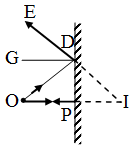
Now, ∠EDG = ∠DIO (DG || IO),
∠EDG = ∠GDO (law of reflection), and
∠GDO = ∠DOI (DG || IO).
Hence, ∠DIO = ∠DOI
∴ OD = DI
Now OP2 = OD2 – DP2, and
PI2 = DI2 – DP2
From (i), since OD = DI, OP2 = PI2 or OP = PI.
So, in the case of a plane mirror, the image is formed as far behind the mirror at the same distance as the object is in front of it.
Some Important Results About Reflection From Plane Surfaces
Lateral inversion : When you see your image in a vertical plane mirror such as that fixed to an almirah, the head in the image is up and the feet are down, the same way as you actually stand on the floor. Such an image is called an erect image. However, if you move your right hand, it will appear as if the left hand of your image is moving. If you keep a printed page in front of a plane mirror, the image of the letters appear erect but inverted laterally, or sideways. Such an inversion is called lateral inversion.
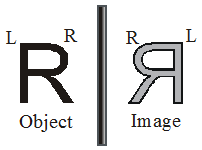 Relative motion of object and image :
Relative motion of object and image :
Case I :
If an object moves towards (or away from) a plane mirror at speed v
 The image will also approach (or recede) at speed v
The image will also approach (or recede) at speed v
The speed of image relative to object will be
v – (–v) = 2v.
Case II :
If the mirror is moved towards or (away from) the object with speed ‘v’
The image will move towards (or away from) the object with a speed ‘2v’.
Multiple Reflection
Number of images formed by combination of plane mirrors depends upon angle between mirrors.
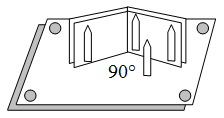 If there are two plane mirrors inclined to each other at an angle 90° , the number of images of a point object formed are 3.
If there are two plane mirrors inclined to each other at an angle 90° , the number of images of a point object formed are 3.
Deviation : d is defined as the angle between directions of incident ray and emergent ray. So if light is incident at an angle of incidence i,
δ = 180° – (∠i + ∠r) = (180° – 2i)
[as ∠i = ∠r]
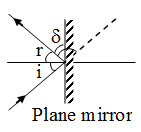 So if light is incident at angle of 30°,
So if light is incident at angle of 30°,
δ = (180° – 2 × 30°) = 120° and for normal incidence ∠i = 0°, δ = 180°
Characteristics of the image formed by a plane mirror :
- The image formed by a plane mirror is virtual.
- The image formed by a plane mirror is erect.
- The size of the image formed by a plane mirror is same as that of the size of the object. If object is 10 cm high, then the image of this object will also be 10 cm high.
- The image formed by a plane mirror is at the same distance behind the mirror as the object is in front of it. Suppose, an object is placed at 5 cm in front of a plane mirror then its image will be at 5 cm behind the plane mirror.
- The image formed by a plane mirror is laterally inverted, i.e., the right side of the object appears as the left side of its image and vice-versa.
